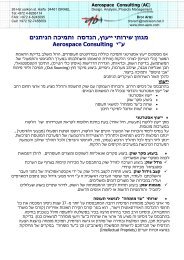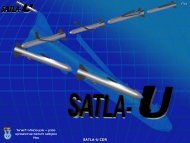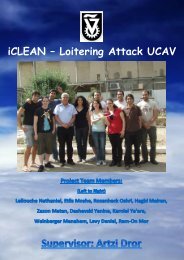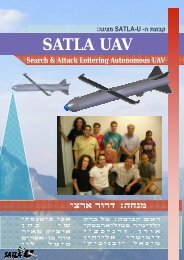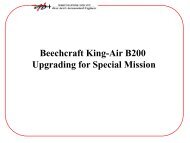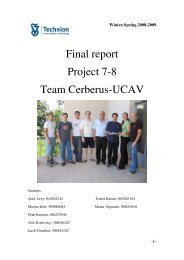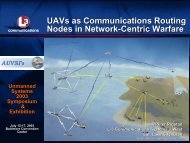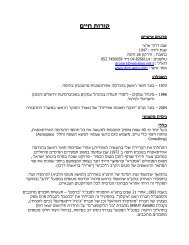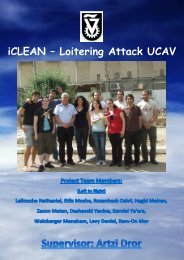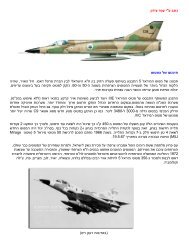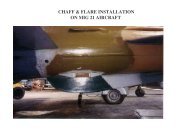Israel Aircraft Industries (IAI) Lavi - aero.com
Israel Aircraft Industries (IAI) Lavi - aero.com
Israel Aircraft Industries (IAI) Lavi - aero.com
You also want an ePaper? Increase the reach of your titles
YUMPU automatically turns print PDFs into web optimized ePapers that Google loves.
Bombs<br />
The <strong>Lavi</strong> could carry the Mk 80 series of bombs (113 kg Mk 81, 227 kg Mk 82, 454 kg Mk 83, and 907<br />
kg Mk 84) with an explosive content of circa 50 per cent. The Mk 80 series are based on studies done<br />
by Douglas <strong>Aircraft</strong> in 1946. The production began during the Korean War (1950 to 1953), but the<br />
first saw first service in the Vietnam War (1965 to 1973). During the Vietnam War, the Mk 81 bomb<br />
was found to be ineffective, and the use was discontinued. A number of different fins can be fitted to<br />
the Mk 80 series. The low drag fins include the low drag, general purpose (LDGP) fin and the high<br />
drag fins include the air inflatable retard (AIR) fin and the Snakeye (SE) fin. The Korean Warvintage<br />
340 kg M117 bomb has an explosive content of circa 65 per cent and was widely used during<br />
operation Desert Storm by the Boeing B-52G Stratofortress.<br />
Cancellation<br />
The total cost for the development and production of the <strong>Lavi</strong> was 6,400 million US dollar in 1983<br />
and approximately 40 per cent was paid by the US government. The fly-away price for the <strong>Lavi</strong><br />
would be between 15 and 17 million US dollar. The development costs of 1,370 million US dollar were<br />
relatively low, because much use was made of existing technology.<br />
Even before the first <strong>Lavi</strong> (B-01) flew, the storm clouds were gathering. In 1983, the US government<br />
refused to give the export licences for a number of essential parts (for example the wings), because the<br />
parts provided high technology products. A total of 80 US firms would provide technology through<br />
licences. In 1984 the licences were awarded. Furthermore, the US government was not prepared to<br />
give money and technology to an aircraft that could be a major concurrent for the F-16C/D and the<br />
F/A-18C/D on the future export market.<br />
In the spring of 1985, <strong>Israel</strong> was in an economic depression and the <strong>Lavi</strong> program was almost<br />
canceled.<br />
Then, a dispute arose as to the final unit cost, the <strong>Israel</strong>i figure being far less than the US calculations<br />
showed. The US Congress withdrew financial support for the <strong>Lavi</strong> program.<br />
The <strong>Israel</strong>i government could not finance the project without US support and canceled the <strong>Lavi</strong><br />
program on 30 August 1987. The vote was 12 to 11 to cancel the <strong>Lavi</strong> program. After the cancellation<br />
the US government offered the A-10A, AH-64A, AV-8B, F-15I, F-16C/D and UH-60A as replacements<br />
for the <strong>Lavi</strong>, all <strong>Israel</strong>i wishes that were previously rejected. In May 1988, <strong>Israel</strong> ordered 30 F-16C<br />
Block 40 and 30 F-16D Block 40 under Peace Marble III.<br />
The <strong>Lavi</strong> program was a truly national program, and everyone in <strong>Israel</strong> followed the progression.<br />
The cancellation of the program was a true sad event.<br />
After the Cancellation<br />
Although the flight performance envelope was not <strong>com</strong>pletely explored, it seems probably that the<br />
<strong>Lavi</strong> would have been at least the equal of the F-16C/D in most departments, and possible even<br />
superior in some. It had been calculated that the <strong>Lavi</strong> could reef into a turn a full half second quicker<br />
than the F-16, simply because a conventional tailed fighter suffers a slight delay while the tailplane<br />
takes up a download, whereas with a canard fighter reaction is instantaneous. By the same token,<br />
pointability of canard fighters is quicker and more precise. Where the <strong>Lavi</strong> might really have scored<br />
heavily was in supersonic maneuverability, basically due to the lower wave drag of a canard delta.<br />
It was originally planned to use <strong>Lavi</strong> B-03 as a ground test vehicle, but it was <strong>com</strong>pleted as a two-seater, by<br />
using parts of either the <strong>Lavi</strong> B-01 or the <strong>Lavi</strong> B-02, and had approximately 15 per cent larger elevons. The<br />
<strong>Lavi</strong> TD (Technology Demonstrator) carried a belly-mounted instrumentation and a telemetry pod. The <strong>Lavi</strong><br />
TD was rolled out after the cancellation of the program. It was intended as a demonstrator for <strong>IAI</strong>'s advanced<br />
fighter/cockpit technologies, which the <strong>com</strong>pany is applying by retrofit to a number of earlier <strong>com</strong>bat aircraft,



